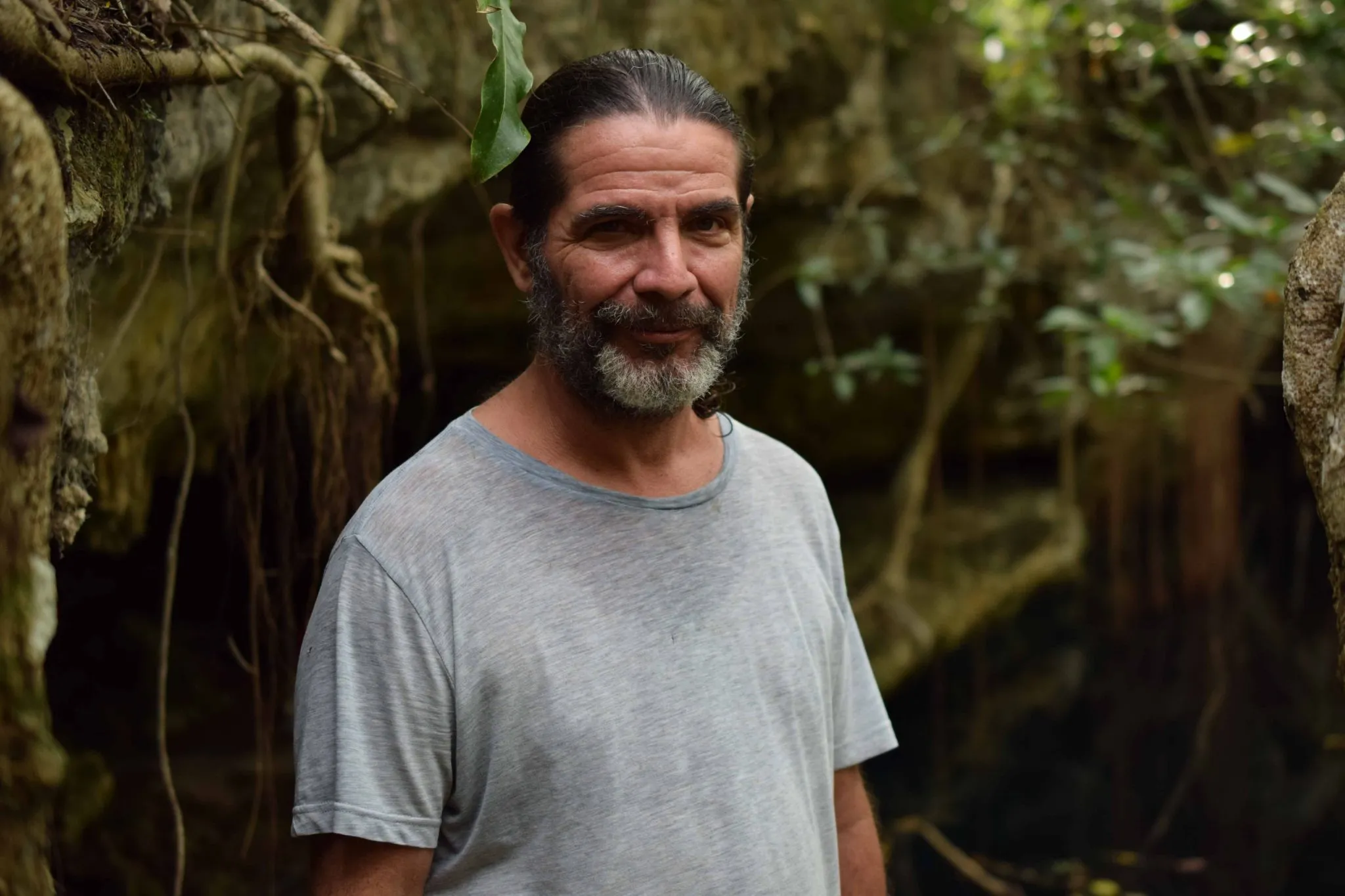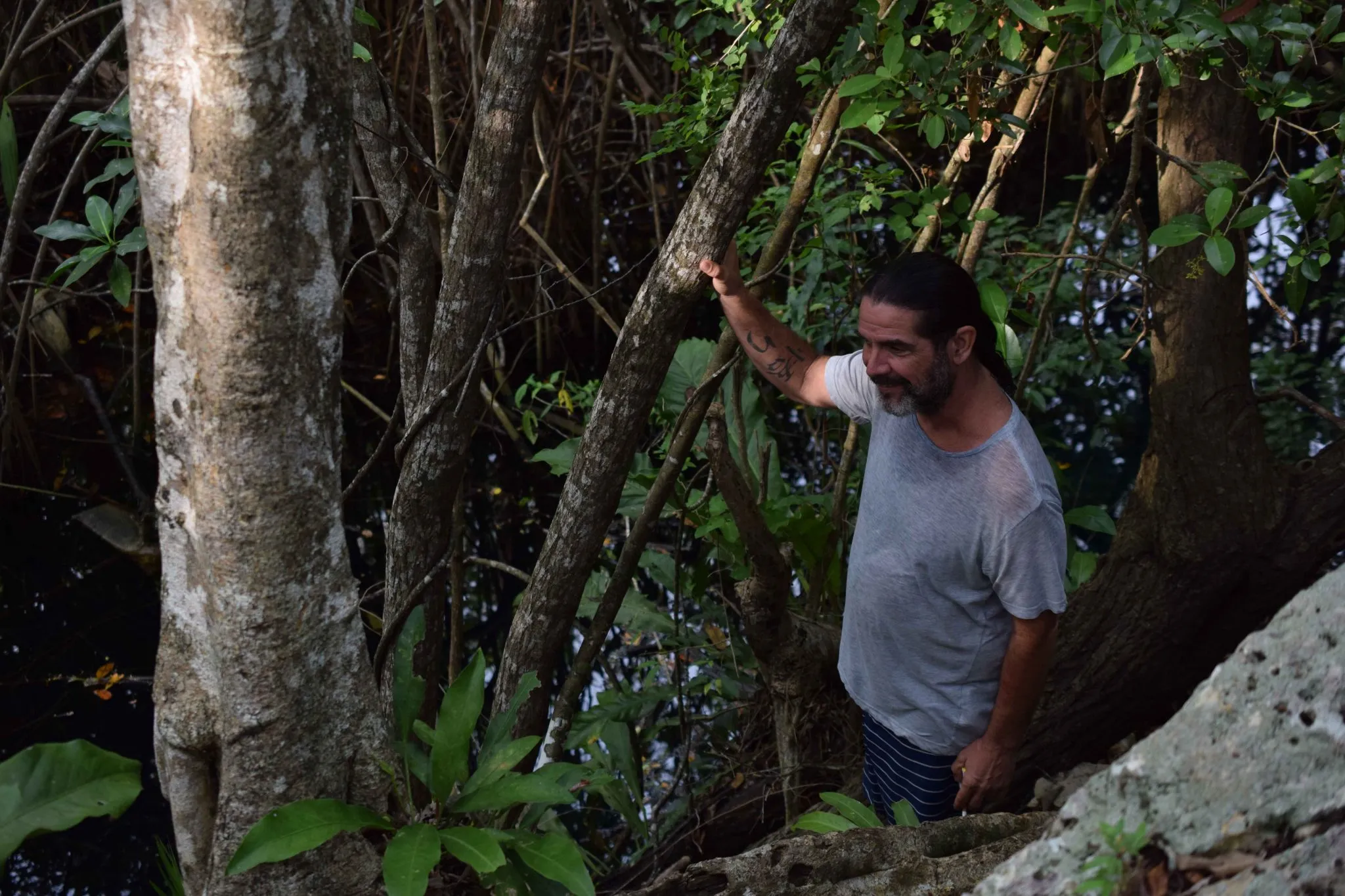
On a recent visit to Tulum, Lily Dayanim, met with local environmentalist, Cuitlahuác in Tulum, Mexico.
The Riviera Maya, the region which Tulum is located, has seen unprecedented change over the past 20 years. Cuitlahuác breaks down the realities the region faces, how its unique geographical structures known as “Cenotes” were formed, the changes he has witnessed over the past 40 years, and informs us how impactful our decisions can be on the environment and local communities.
Q: Can you please tell us our name, where you’re from, how long you’ve been living here, and what you do?
A: My name’s Cuitlahuác. Everybody knows me as “Captain Quickie,” and I was brought here in 1983 from Los Angeles. When we moved here, there were two hostels in Cancún. Playa del Carmen was a fisherman village with about 17 families. We lived in the Riviera Maya. My parents were kind of hippies that decided to roll the dice and help pioneer the area. We have a restaurant in the area known as “Oscar and Lalo.” I grew up in the food and services industry. Me and my brother started the jungle snorkeling tours when we were kids out of boredom because there was basically fishing, diving, and partying. As kids, there are only so many times you can go to the beach before you get bored and want to do something else. So that’s when we started taking other kids to the jungle, trekking through it, and finding these sinkholes that were cenotes, and eventually, we started charging people to take them snorkeling.
Over the last 40 years– I cry to see the changes, as what some people would call “progress.” But I can’t be a hypocrite about it because I’m a migrant to this area myself. I help try and raise consciousness and help other people at least become good stewards of the environment. Our “trusted leaders,” that are our elected officials are so proud of their projects. They don’t realize that people keep coming here despite their projects but because of the natural beauty, not because of their projects. So, Playa Del Carmen, for example, is the fastest-growing city in all of Latin America. From 2007 to 2015, it was the fastest-growing city in the world. So the carbon footprint that humans are leaving behind is outrageous. We were talking earlier about Tulum and how “namaste” it is, but they have a major trash and sewage problem. Right now, I’m actually working on a project to bring some international money funds to the area from the World Bank to help address the sewage and trash problem of Tulum. We’re trying to address this because the local government isn’t doing anything about it. And there’s not much help with the federal government either.
Another problem we have in the area is the loopholes in the tourist visa. A lot of people live here on a tourist visa, and they’re not taken into account with the census. So federal funds that come into the area for infrastructures like hospitals, roads, sewage, drainage, and water, are not being allocated appropriately. There’s an undercount of migrants in the area that live here on a tourist visa. I think that’s one of the reasons there’s been a major crackdown in recent months on people that are violating those loopholes. It’s been a crackdown because not only are these 180-day visas being used to the extreme to live here full-time, there’s also the fact that people are just ignoring it and living here with expired visas thinking that they’re untouchable.
Q: How were the cenotes in this area created?
A: A meteor hit the planet allegedly 65 million years ago, and it sent a plume of ash and smoke around the planet with the impact that blocked the sun rays and stopped the rain cycles. It brought on an ice age. The polar ice caps grew, the sea levels dropped, and the Peninsula of Yucatan was an underwater reef that revealed. Coral, once it was out of the water, died. Coral is an animal. When an animal dies, it decomposes, lets off gases. Some of those gases got caught under the bedrock. So after a few thousand years, the impact blast settled. When the rain cycle started again, the rainwater seeped through the porous limestone that is calcium carbonate. When it met the gases under the bedrock, it caused them to expand, and it started to erode from the inside out. The caves were produced by erosion. When we first started scuba diving the caves forty years ago, we started finding human remains, and we chalked them up as Mayan sacrifices, but the deeper and deeper we went, we started finding artifacts, stockpiles of carbon, and remnants of bonfires. And in 2005, we found a 5-foot mammoth pelvis bone, and that was a big red flag, so we brought in researchers from the National University and Yale University. When they carbon-dated it, it came back 15-17 thousand years old. So apparently, humans and prehistoric animals were finding refuge during the ice age in the cave system. It was with the melting of the Wisconsin glaciers that the sea levels rose. The water logged the caves because you have stalagmites and stalactites underwater, and that would be impossible to form if there was not a dry environment. This whole peninsula is swiss cheese riddled with caves and fossils because it was just an underwater reef 65 million years ago.
Over the last 40 years– I cry to see the changes, as what some people would call “progress.” But I can’t be a hypocrite about it because I’m a migrant to this area myself. I help try and raise consciousness and help other people at least become good stewards of the environment. Our “trusted leaders,” that are our elected officials are so proud of their projects. They don’t realize that people keep coming here despite their projects but because of the natural beauty, not because of their projects. So, Playa Del Carmen, for example, is the fastest-growing city in all of Latin America. From 2007 to 2015, it was the fastest-growing city in the world. So the carbon footprint that humans are leaving behind is outrageous. We were talking earlier about Tulum and how “namaste” it is, but they have a major trash and sewage problem. Right now, I’m actually working on a project to bring some international money funds to the area from the World Bank to help address the sewage and trash problem of Tulum. We’re trying to address this because the local government isn’t doing anything about it. And there’s not much help with the federal government either.
Another problem we have in the area is the loopholes in the tourist visa. A lot of people live here on a tourist visa, and they’re not taken into account with the census. So federal funds that come into the area for infrastructures like hospitals, roads, sewage, drainage, and water, are not being allocated appropriately. There’s an undercount of migrants in the area that live here on a tourist visa. I think that’s one of the reasons there’s been a major crackdown in recent months on people that are violating those loopholes. It’s been a crackdown because not only are these 180-day visas being used to the extreme to live here full-time, there’s also the fact that people are just ignoring it and living here with expired visas thinking that they’re untouchable.

Subscribe To Our Newsletter
Subscribe for exclusive insights, upcoming panels, inspiring stories, and opportunities to support communities driving real change.
Q: What are the major environmental and cultural shifts that you’ve seen over the past 40 years?
Unfortunately, here we are 40 years later, and the natives have become very brought up into the 21st century. They’ve become just like every other advanced civilization: very addicted to their technology, to their TVs, to their cell phones. But it’s funny because if you take a road trip inland just about an hour, you will see how Mayans are living just as they did 100 years ago with the occasional logo for Nike or Adidas.
One of the best restaurants that I like to go to in Tulum is “Don Beto’s.” If you like pork, I’d highly recommend going to it. It’s the pulled pork where they do it underground. And when you go there, I always explain to my guests, be prepared for some cultural differences. They sweep the place once a day in the morning, the woman is handling the food with her hands right in front of you, and tables are only cleared when they are needed. But, it’s one of the best pulled-pork tacos in the area because they grow the swine on their property without hormones, without feed. It’s basically free-range pork, and they grow the corn that they grind down to make the handmade tortillas. So that’s just one of the things you see nowadays where there’s a little bit of integration between the past with the present. It is a traditional Mayan family offering their cultural cuisine but in the heart of a tourist area which is the booming Riviera Maya.
Q: In terms of environment and natural resources, how has the area been impacted?
Q: How have you contributed to the environmental preservation of the cenote and other areas?
Q: Is there anything else you want to add regarding tourism or preservation in the area?
Just remember, the planet’s been around for billions of years and will continue to be around for billions of years. Eventually, it’s just going to get tired and shake us off like the parasites that we are. We need to save our homes which this planet has been so generously providing for us.